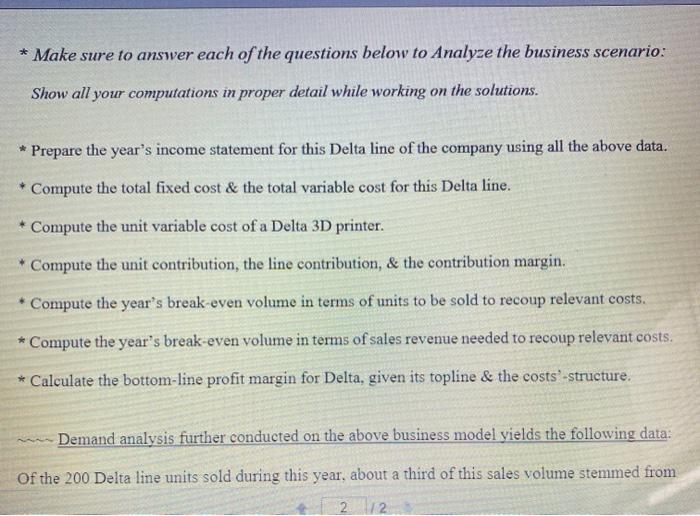Prin Tech Inc. has served the American market for 3D Printers for almost a decade. The company recently launched its Delta line of 3D Printers positioned for designing and fabricating small components and assemblies that fit within variety of b2b type commercial and light manufacturing operations within respective industries as needed. The marketing team was allotted $7,500 for specific applied marketing research activities to gather intelligence on the viability of this Delta line. The stipulation was clear that this amount would be fully expensed during the first year itself if the Delta line made commercialization. This did indeed happen, as the Delta line's first year sales revenue closely matched their forecast. The company manufactures these printers in their regular factory as a make-to-order batch production schedule timed to demand as per the orders brought in by their salesforce. The ready printers are packaged/labeled and moved as finished goods inventory to their distribution center where they track and dispatch respective orders of customers. A freight carrier thereupon picks up these printers from the distribution center and delivers to the respective customers. A Delta 3D Printer is competitively priced at $5,000. They sold 200 units during the year. For each printer, the direct costs for procurement of the technical machineries & technological mechanisms, raw material, packaging/labeling, & labor that go into getting a printer ready for dispatch are estimated at 45% of the selling price. The distribution center charges the company an inventory holding fee of $80 per month for the space that these packaged printers occupy in their holding facility prior to transit. The freight carrier company has negotiated a shipping cost of $50 for each of these Delta printers which it delivers from the distribution center to the ordering customers. WIL GOIVOISTUMI MISUTULIVUI TITU VICIULITE OULUT The salesforce allocation for this Delta line has been estimated at 15% of sales revenue. The company purchased a sales territories-tracking module costing $3,000 dedicated to the Delta line for this sales team's real-time usage on their enterprise information system as viewable on their tablets when in the field as well as in the office. The sales team has been granted a limited cafeteria allowance of $2,500 total when in travel. The marketing communications group has developed a multi-touchpoints advertising & promotions plan for pushing the demand of this Delta line in their target markets. They bought a clipping service list worth $1,500 from a syndicated data source for determining the optimal message content to outlay in their ad campaign to effectively showcase this line. They run a print ad year-long in a major trade magazine for which the weekly rate is $165 per ad. The Delta ad appears once every week & provides the needed visibility of the brand & this line. The sales promotions allowance allocated for the Delta line is 3% of sales revenue, and the sales team is encouraged to push these promotions to stimulate clients' spot interest & book the sale. The advertising group also engages in direct communications with several potential customer using client mailers specifying product information with pictorials & technical specifications to focus buyers' attention. The budget for printing & posting these mailers is set at $4,000. For the first 6 months of the year, the company showcased this Delta line at the popularly visited Corporate Supplies Expo event held every month. They incurred a cost of $400 each month to conduct a booth at this Expo whereby they can develop utilizable leads, network with potential customers, & pitch to clients for further prospecting toward closing orders. Beyond all the above operating expenditures, the company has budgeted $120,000 for general & administrative functions to support this Delta product line, along with a $45,000 appropriation for indirect costs toward tooling, supplies, utilities. & maintenance purposes for the Delta line. * Make sure to answer each of the questions below to Analyze the business scenario: Show all your computations in proper detail while working on the solutions. * Prepare the year's income statement for this Delta line of the company using all the above data. + Compute the total fixed cost & the total variable cost for this Delta line. * Compute the unit variable cost of a Delta 3D printer. Compute the unit contribution, the line contribution, & the contribution margin. Compute the year's break-even volume in terms of units to be sold to recoup relevant costs. * Compute the year's break-even volume in terms of sales revenue needed to recoup relevant costs. * Calculate the bottom-line profit margin for Delta, given its topline & the costs-structure, Demand analysis further conducted on the above business model yields the following data: Of the 200 Delta line units sold during this year, about a third of this sales volume stemmed from 22 * Calculate the bottom-line profit margin for Delta, given its topline & the costs-structure. Demand analysis further conducted on the above business model yields the following data: Of the 200 Delta line units sold during this year, about a third of this sales volume stemmed from overall market growth of 3D printers and substantial timely competition provided by the Delta model to other companies in the marketplace. The remaining volume of Delta's unit sales came from other existing models (Pryme, Zione, Elyftis) already being marketed by PrinTech Inc. - thereby, among these Delta sales units came 25% from Pryme, 40% from Zione, 35% from Elyftis. * Accounting for this above information, Compute the sales figures in units for the Delta model in terms of its 'net new sales volume' & its cannibalized sales volume










